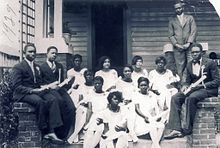User:Dnwollard/sandbox
Joseph N. Crooms (so known as J. N. Crooms) (June 17, 1880 - March 14, 1957) was an African American Principle and Educator, who founded Crooms Academy in Goldsboro, Sanford, FL in 1926. He established two schools for African American students in Seminole County. The first being Hopper Academy, and then Crooms Academy the first Four-Year High School for African Americans in Seminole County.
Early Life and Education
[edit]Joseph Crooms was the 5th child born to parents Moses and Daphne Crooms in Orlando, Florida in 1880. Both were freed slaves from the Tallahassee area. Moses was most likely born on the Goodwood Plantation and excelled in carpentry. Daphne was well educated since she was girl, and emphasize the importance of education to all of her children and grandchildren. Census records show Moses and Daphne living in Monticello for a several years, before they moved their family down to Orlando[1]. Moses had worked with a railroad company, and saved up enough money to buy several plots of land of the west side of Orlando in the Black Community of Jonestown. The Crooms family would become well known in the Black Community of Central Florida. Many of the Crooms Children would succeed in the Education field, and Ministries.
In 1906, Joseph and his Wife Wealthy Richardson Crooms moved to Sanford, FL. Joseph had taken a job as the Principle of Hopper Academy, and under his guidance, he helped build the school house that still stands today.[2]

Sanford Legacy and Crooms Academy
[edit]
Hopper Academy, located at 1101 South Pine Avenue, was built in 1906. At this time, it served as the only school for African-American children in Seminole County[3]. Structured after the Booker T. Washington's Tuskegee Institute, the curriculum was trade and agriculturally based, and grades only went up to the 10th grade. The academic terms would reflect the scheduling of the harvest months, allowing the children to still help their parents in the fields. The schools were designed to teach the students basic skills, that they could to take back to their rural black communities, and continue to prosper with their learned skills.[4]
Joseph Crooms saw the opportunity to expand the curriculum of Hopper Academy, and include a wider range of academic subjects, such as arts and sciences. Joseph and Wealthy Crooms, donated 17.5 Acres of land in the, Historical Town of Goldsboro, and began building their new school. It would become Crooms Academy, a four year High School dedicated to the enrichment and empowerment of young black lives. In addition to establishing a Quarter Academic Term. Crooms Academy opened in 1926, and Hopper Academy became the Elementary-Middle School, with levels ranging from Kindergarten to 8th grade. [5] Crooms Academy and it's founders, Joseph and Wealthy, were pioneers in the education of African American students. Crooms Academy allowed students access to visual, performing, and musical arts and sciences.[6]
Personal Life
[edit]Joseph and Wealthy were active members in their community. They were known to take in boarders and give them jobs in their school as teachers, librarians or staff.[1] They also took in children who need somewhere to live, for instance Clifford Joel Hurston, the younger brother of the Harlem Renaissance Writer, Zora Neale Huston. After their mother died in 1904, the Hurston children were sent to live with family and friends. Clifford Joel would become their unofficially adopted son.In 1920, The Crooms' built their home on 812 South Sanford Ave in the neighborhood of Georgetown. It was one of the many buildings designed by a local African American architect named Prince W. Spears.[7] It became a tradition for alumni of Hopper and Crooms Academy to take their graduation class portraits with Joseph on the brick steps of his house. Crooms Academy would also perform yearly parades down South Sanford Ave, with baton twirlers and marching bands. [6]
Joseph was a talented piano player, and taught choir at the Academy in addition to giving piano lessons out of his home. He was known to be strict and would smack the knuckles of his students with a ruler if they missed a note.
Joseph was also good friends with Mary McLeod Bethune. Together, they founded the Bethune Beach Corporation, and also purchased beach property and built one of the few motels on the Atlantic ocean that catered to people of color.
Death
[edit]On March 15, 1947, Joseph Crooms suffered a stroke and passed away. There was a wake service provided in the parlor of his home on Sanford Ave. He was mourned by not only his family, but the hundreds, if not thousands, of students who graduated from Hopper and Crooms Academy.
- ^ a b "Ancestry® | Genealogy, Family Trees & Family History Records". ancestry.com. Retrieved 2016-06-16.
- ^ Sentinel, Orlando. "Sanford city leaders not so sure about giving money to restore old Hopper Academy building". OrlandoSentinel.com. Retrieved 2016-06-17.
- ^ Roberts, Gary (Aug 14, 2011). "Georgetown vs Goldsboro". Sanford Herald. Sanford Herald. Retrieved June 16, 2016.
- ^ Blended Lives: An American Family's Journey From Bondage To Triumph. Tallahassee, Florida: John G. Riley Center/Museum of African American History & Culture. 2003. OCLC 61298969.
- ^ Documentary Film. "Goldsboro: An American Tale" 2006. Produced by University of Central Florida.
- ^ a b Flewellyn, Valada S (2009). African Americans of Sanford. Charleston, SC: Arcadia Pub. OCLC 320804616.
- ^ Stock, Gregory; AIA; Bd+c, Leed (2015-04-08). "Prince Spears Legacy of Local Building to the Black Communities". Orlando Regional Center for Architecture and Design (ORCAD). Retrieved 2016-06-16.

